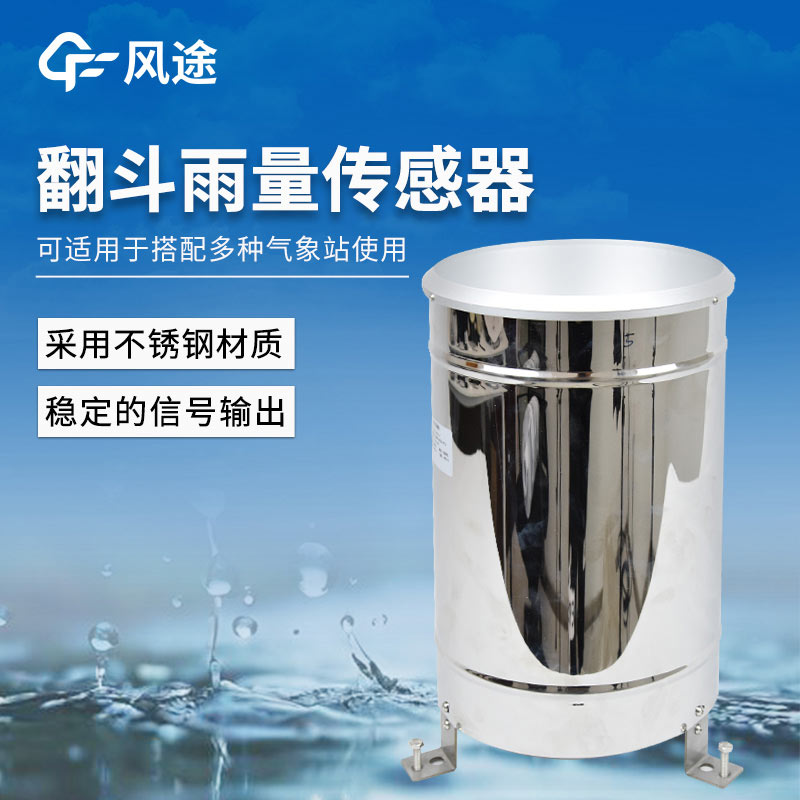Shandong Fengtu IOT Technology Co., Ltd
Sales Manager:Ms. Emily Wang
Cel,Whatsapp,Wechat:+86 15898932201
Email:info@fengtutec.com
Add:No. 155 Optoelectronic Industry Accelerator, Gaoxin District, Weifang, Shandong, China

Sales Manager:Ms. Emily Wang
Cel,Whatsapp,Wechat:+86 15898932201
Email:info@fengtutec.com
Add:No. 155 Optoelectronic Industry Accelerator, Gaoxin District, Weifang, Shandong, China
time:2025-07-10 09:34:16 source:Weather Station viewed:231 time
The Stainless Steel Tipping Bucket Rain Gauge is the most classic rain gauge. It collects rainwater through an inclined funnel. When the rainwater reaches a certain amount, the tipping bucket below tilts and dumps the water. After the sensor detects this action, the rainfall can be determined.
It can record precipitation in real time and accurately, unaffected by dust or shadows, and can maintain high measurement accuracy even under severe weather conditions. Moreover, the national standard GB/T 21978.2-2014 provides unified technical specifications and quality standards for the production, testing, and use of tipping bucket rain gauges.
The editor reminds that when choosing a tipping bucket rain gauge, the following key points that comply with national standards should be focused on:
Structure and composition: It can be divided into single-layer, double-layer, and three-layer forms according to the number of tipping bucket layers. For example, the upper layer of the double-layer Stainless Steel Tipping Bucket Rain Gauge is a transition bucket, and the lower layer is a measuring bucket, which can evenly inject precipitation of different intensities into the measuring bucket, improving detection accuracy.
Measurement accuracy: Within the rainfall intensity range of 0.01mm/min to 4.0mm/min, the accuracy is divided into three grades. High-quality products can achieve an error of ≤±2%, reaching Class I accuracy, and have passed professional institution testing.
Rain collection mouth: The inner diameter needs to be φ200mm, the edge is blade-shaped, the angle is between 40° and 45°, the inner wall is smooth, and the depth is at least 100mm. The material is mostly 304 stainless steel to prevent rainwater splashing and corrosion.
Resolution: There are various specifications such as 0.1mm, 0.2mm, and 0.5mm available, which should be selected according to actual needs.
Rainfall measurement intensity range: The conventional measurable range is 0mm/min to 4mm/min, the maximum allowable rain intensity is 8mm/min, and some products support customization for greater rain intensity.
Output: The signaling element is recommended to use a reed switch, which meets national standard requirements and can ensure the stability of signal output.

The Visibility and Present Weather Sensor is an automatically continuous monitoring sensor, whose main monitoring targets include visibility, precipitation conditions, and specific types of visibility-impairing weather phenomena.This device works based on the forward scattering principle. It activel...
When we visit some parks and scenic areas, we often see an electronic screen on which real-time meteorological data, as well as negative oxygen ion and PM content, etc. are displayed. This is the Negative oxygen ion monitoring system.The Negative oxygen ion monitoring system can not only monitor the...
Micro-meteorology refers to the atmospheric conditions within small-scale areas near the earth's surface. Key monitoring parameters include wind speed, wind direction, air temperature, humidity, atmospheric pressure, and optionally, rainfall. These parameters exhibit significant gradient variati...
The safe flood - season operation of reservoirs has always played a crucial role in China's flood prevention and control work, and it is also extremely challenging. Small and medium - sized reservoirs have become the weak links in the entire flood - prevention system. At present, most of these s...